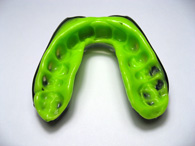New Technology that people do not seem to know about

The Mamori is a mouthguard equipped with inertial sensors designed to detect strong impacts or possible injuries in the brain while doing physical activity.
January 28, 2016
We have a natural tendency to glorify the inventions which receive the most attention in the media, while forgetting those inventions which do not receive media exposure. Sometimes, even the unknown technologies can change the world. Some of these potential world changing technology companies include SCiO, foldscope, Mamori, and Orbsys.
SCiO, or as the company calls themselves, “the Sixth Sense,” created a molecular sensor that allows users to determine the chemical formation of physical items with just a picture.The technology works by comparing a picture to items stored in a cloud-based directory. Chemical formula information found in similar-looking items are then sent back to your phone. Sure, scanning arbitrary items for no particular reason could be a lot of fun, but the SCiO is also capable of scanning food (for nutritional information), medicines, plants (for health purposes), oils, plastics, and wood.
Another less-known invention is the foldscope which was developed by a group of students at Stanford. Microscopes can be a bit bulky and expensive, especially for school’s purposes, but since microscopes are a major part of science classes, it is necessary that schools have functioning and affordable microscopes. The foldscope is basically a foldable microscope, crafted primarily out of paper. And in spite of its lightness and price of only fifty cents, the foldscope is surprisingly effective. According to the creators,the foldscope can provide over 2,000X magnification, it weighs less than two nickels, it requires no external power, and it can survive being dropped from a 3-story building or being stepped on by a person.
In the same fashion as the foldscope, the Mamori is also not very well-known. Essentially, the Mamori is a modernized mouthguard that further protects sport’s players from permanently damaging both their brains and their futures. In recent years, concussions have become a common health issue for many sports players. According to the The Centers for Disease Control, there is an estimated 1.6 to 3.8 million sports-related concussions in the United States every year. In addition to the high numbers of concussions reported annually, it is also extremely difficult to detect a concussion, and unknowingly allowing athletes to play with one can lead to permanent brain damage. The Mamori is a mouthguard equipped with inertial sensors which constantly monitor for movement. The information is then sent to a laptop, which can track whether or not the collision was severe enough to cause a concussion.
Likewise, the OrbSys is a modernized shower system. Showers waste a tremendous amount of water and require a huge amount of energy. According to the US Environmental Protection Agency, every year, 1.2 trillion gallons of water are used to shower in the U.S. alone. The OrbSys claims to reduce water use by a shocking 90 percent and energy use by 80 percent. Inventor Mehrdad Mahdjoubi estimates that switching over to the Orbsys will reduce energy and water bills by up to $1,351 per person annually. The OrbSys recycles shower water by pumping it through a filter, and the clean water that comes out of the filter needs to be heated minimally. This leads to less energy being used. Atop of being both environmentally and economically beneficial, Mahdjoubi said that due to the fact that the Orbsys maintains a steady water temperature, and releases more gallons of water per minute than the traditional shower, the Orbsys provides an improved shower experience. If the Orbsys ever did replace traditional showers, the amount of energy and water saved would be incredible.
Although these devices are relatively unknown, they do find very practical uses in daily life. From something as small as a paper microscope to a device capable of revolutionizing the way we take showers, these devices are able to make a huge impact.
















